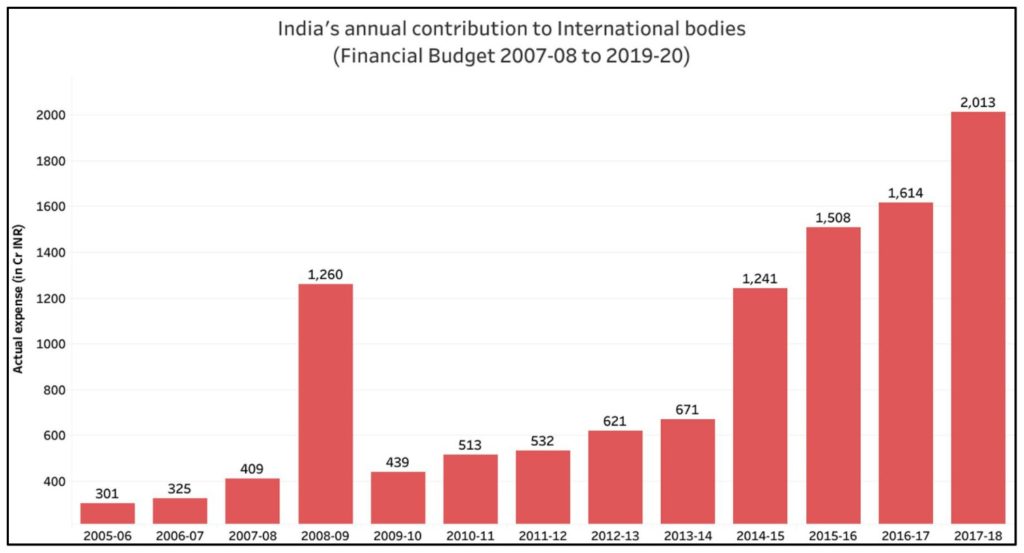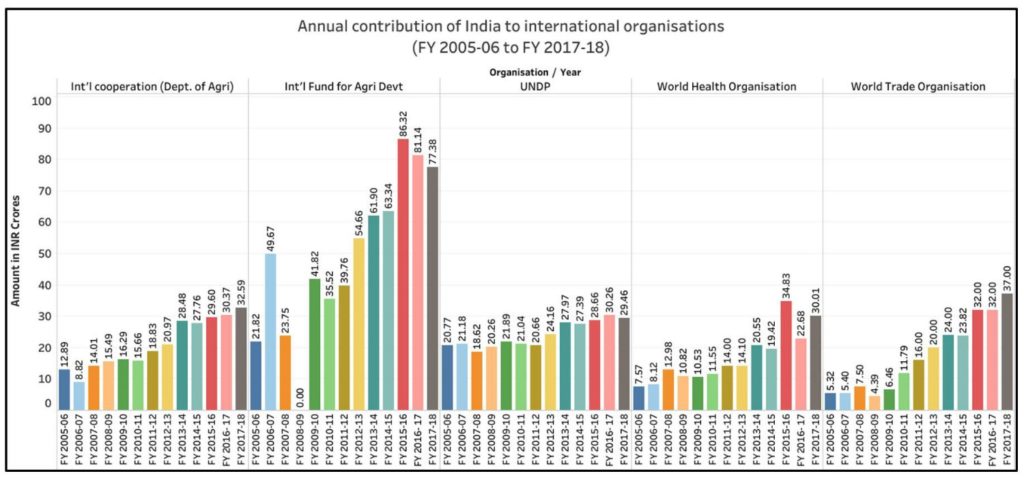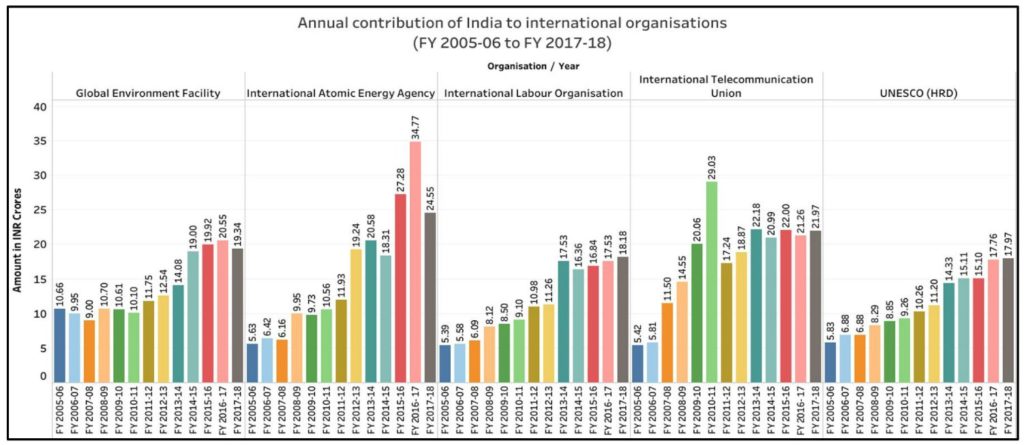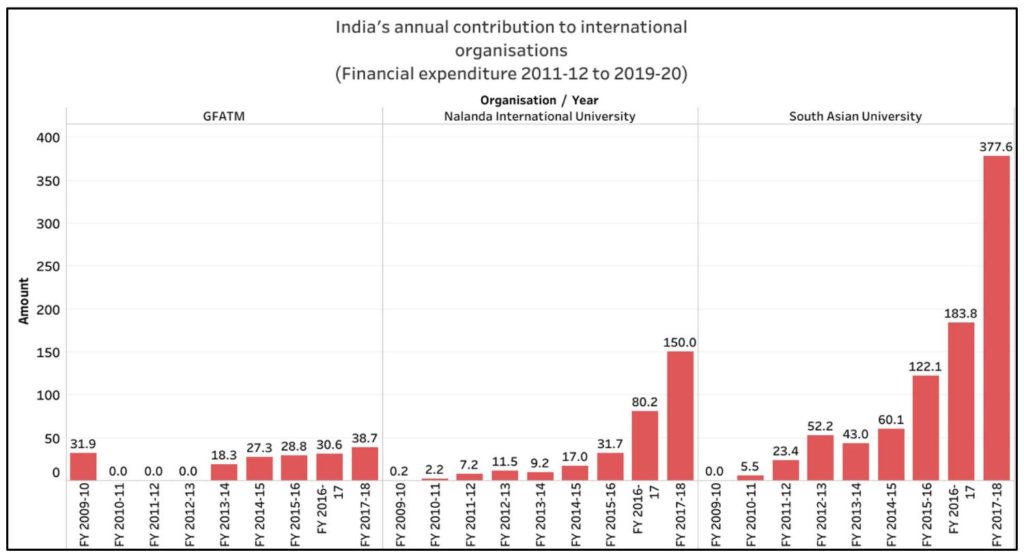[orc]In addition to the UN, India contributes annually to various international organizations. Between 2005-06 & 2017-18, India’s contribution to various international organizations has increased 7 times.
In an earlier story on Factly, the funding structure of United Nations was explained along with the contribution by various countries. India’s contribution to the UN was also discussed in the story.
Similar to United Nations, there are various other international organisations such as World Health Organisation, United Nations Development Programme, International Labour Organisation etc. to which India contributes like other countries. For developing countries like India, achievement of developmental goals is possible only through collaboration with such multilateral agencies. Global issues such as poverty, health, terrorism, environmental concerns and pandemics too need to be addressed for which involvement in activities of international organisations that work with a common objective will be the most effective. In this story, we take a look at India’s pecuniary contributions. As per the data presented during the budget, India contributed to more than 150 International bodies in 2017-18.
Those contributions made by India above ₹ 15 crores in the financial year 2017-18 have been taken into consideration in this study.
Compared to 2005-06, India’s contribution has increased almost 7 times
The focus of this story is on India’s contribution to international bodies since 2005. Over the span of 12 years, India’s actual expenditure through contribution to these bodies has been increasing gradually. From ₹ 301 crores in financial year 2005-06, India’s contribution to various international bodies has increased to ₹ 2013 crores in financial year 2017-18, an increase of almost 7 times.

In 2008-09, India contributed ₹ 1041.4 crores to the United Nation’s budget and hence a bump in the overall figures. The reasons for such a high contribution in that particular year are not known. In the previous financial year, 2007-08, India’s contribution to the UN was only ₹ 42 crores and in 2009-10, this was around ₹ 104.6 crores.
India started contributing more than ₹ 400 crores annually to IDA since 2014-15
Compared to 2013-14, the expenditure incurred on contributions to international bodies has almost doubled in 2014-15. This is primarily because India started contributing to the International Development Association (IDA) starting 2014-15. The amount contributed to IDA is also high- above ₹ 400 crores annually. India is one among the 35 countries that have graduated from IDA at different times.
The IDA is a global financial institution that was formed in 1960 aimed at providing concessional loans to the poorest developing nations across the world. India graduated from the IDA in the year 2014. Since then, India has contributed ₹ 418 crores in 2014-15, ₹ 445.9 crores in 2015-16, ₹ 454.1 crores in 2016-17 and ₹ 408.3 crores in 2017-18. India has also contributed to the Asian Development fund (ADF) during this period. The amount paid to ADF was ₹ 91.4 crore in 2014-15, ₹ 48.1 crore in 2015-16 and ₹ 50.9 crores in 2016-17. In 2017-18, India paid ₹ 64.5 crores to ADF.
In addition to these, India has contributed ₹ 36.3 crores in 2015-16 and ₹ 67.3 crores in in 2017-18 towards African Development Fund. In 2016-17 and 2017-18, India has also spent ₹ 100.9 crores and ₹ 115.8 crores to fund South Asian Regional Training and Technical Assistance Centre which is a collaborative venture between the International Monetary Fund, member countries and development partners. This centre was inaugurated in 2017. The body has been formed with the objective to reduce poverty and support growth in the member countries of Bangladesh, Bhutan, India, Maldives, Nepal and Sri Lanka.
While contribution to some of these organisations such as the World Health Organisation, United Nations, UNDP, World Trade Organisation and others has been on for decades, contributions made to South Asian University, Nalanda University, IDA, etc. started only recently, in the last decade. For ease of understanding, the top 13 organisations/ bodies to which India contributes have been considered for the following analysis.
India has been regularly contributing to these 10 organisations & the contributions account for 15.3% of India’s total contribution
India has been regularly contributing to certain international agencies. Expense under the International Cooperation of the Department of Agriculture, Cooperation and Farmers’ Welfare includes the contributions made by India to the Food and Agriculture Organisation (FAO) and the United Nations’ World Food Programme (UNWFP). The amount contributed by India towards International Cooperation of the department of Agriculture, International Fund for Agricultural Development (IFAD), United Nations Development Programme (UNDP), World Health Organisation (WHO) and World Trade Organisation (WTO) can be seen in the following chart.

Of these, the contribution made to IFAD is the largest- amounting to ₹ 77.4 crores in 2017-18 alone. Following this are the contributions made to the WTO and WHO. In the following chart, India’s contribution to Global Environment Facility, International Atomic Energy Agency (IAEA), International Labour Organisation (ILO), International Telecommunication Union (ITU) and UNESCO are given.

Global Environment Facility was established in 1992 in order to tackle the pressing environmental issues that required immediate attention. The contributions made to the Global Environment Trust Fund (as referred to in 2009-10 and before) fall under this organisation. The IAEA is an international organisation which works to promote the peaceful, clean and safe use of nuclear energy. India has been a member of IAEA since1957. India’s contribution to UNESCO is made by the Ministry of Human Resources Development (MHRD). It is clear from the data that India’s contribution to each of these organisations has been increasing every year.
Since 2009, India started contributing to GFATM, South Asian University and Nalanda University
India started contributing to Global Fund to fight AIDS, Tuberculosis and Malaria (also known as GFATM), Nalanda University and South Asian University since 2009. The trend in contributions to these organizations is given in the following chart.

GFATM is an international partnership organisation which mobilises funds to provide the local experts to run programs in more than 100 countries to fight AIDS, Malaria and TB which claim many lives every year, especially in the under developed countries. India has contributed an average amount of ₹ 29 crores to GFATM every year since 2009 except between 2010-12. Nalanda University located in Bihar, is an international university supported by the 17 countries which participated in the East Asia Summit. The university started functioning in 2010 under a special act of the Indian parliament. From a mere ₹ 20 lakh at the time of opening, India now contributes ₹ 150 crores to the university annually.
South Asian University is also an international university established by the member nations of South Asian Association for Regional Cooperation (SAARC). Since its inception in 2010, India has contributed substantially and India’s share has increased from ₹ 5.5 crores in 2010-11 to ₹ 377.6 crores in 2017-18.
Apart from these, India does voluntary contributions to more than 150 international bodies also in order to strengthen international relations. The association of a country like India with any international organisation is an important determinant when it comes to diplomacy since it helps in boosting trade and other relations. With the largest diaspora in the world and highest recipient of inward remittances, India’s international ties play a pivotal role in the country’s progress.


